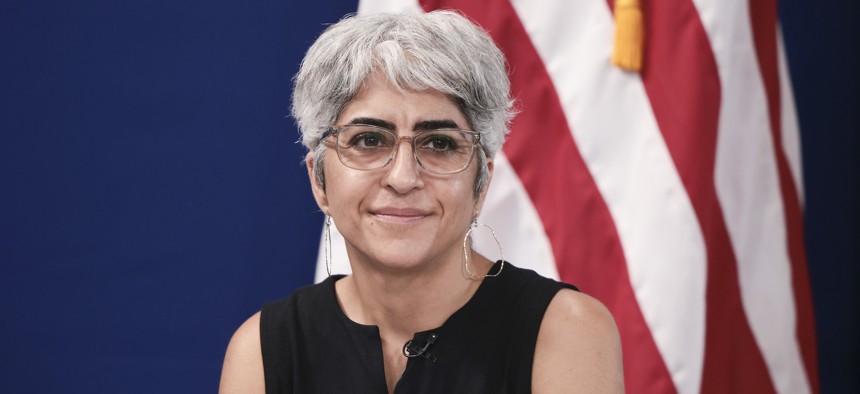OPM head previews coming cyber and IT hiring flexibilities

Director of U.S. Office of Personnel Management Kiran Ahuja appears at a workforce roundtable held in October 2021. Anna Moneymaker/Getty Images
The personnel agency is also gearing up to recruit AI workers into the government as part of a talent surge called for in the recent AI executive order.
HERSHEY, Pa. – A proposal from the Office of Personnel Management meant to help agencies more easily hire for and pay competitive wages to the government’s tech and cyber workforce will be announced within days, Kiran Ahuja, director of the Office of Personnel Management, told attendees at the ACT-IAC Imagine Nation conference Monday.
Ahuja previewed the proposal at the same conference last fall, citing “true angst” amongst the federal HR community at the “competitive disadvantage” most agencies were experiencing because of Congressionally-authorized pay and hiring authorities for cyber talent at the Department of Homeland Security. The Defense Department has similar excepted service hiring authorities for cybersecurity workers.
Now, Ahuja said that OPM has “a proposal coming out very soon about how we want to build equity around pay and flexibilities in the workplace, and taking what DHS has done well and really spreading that to the rest of government,” something she said expects to be “transformative.”
Although the OPM director didn’t lay out many details about what to expect from the proposal, she did tell Nextgov/FCW that the agency’s ideas “will need the partnership of Congress” and agencies “for it to be as far-reaching as we would like it to be.”
Stakeholders can expect OPM to ask for similar hiring, pay and talent management authorities granted to DHS and DOD to be given to other federal agencies, according to a cybersecurity workforce strategy released by the White House’s Office of the National Cyber Director over the summer.
“I think we have got to make it easier and faster to bring people into the government,” Ahuja said, “because we do lose people.”
Last year, Ahuja and the Office of Management and Budget’s deputy director for management, Jason Miller, told lawmakers that the harmonizing of authorities would be necessary to quell internal competition for cyber talent caused by the disparities in what agencies can offer.
Despite its unique hiring exceptions, the DHS Cybersecurity Talent Management System has been slow to take off, in part because of culture and process changes required of DHS hiring managers and HR officials as they set out on what DHS characterized as a wholesale civil service reform effort.
Launched in the fall of 2021, the new cyber talent system has only enabled DHS to hire 127 people as of August. The initial goal was to bring in 150 by the end of fiscal year 2022.
Asked about whether she expected similar challenges at other agencies if they get complementary authorities, Ahuja said that attention and pressure from the White House, OPM and lawmakers would help agencies to make progress.
“People understand the acute need right now and I think there’ll just be a lot of attention… to do this in a shorter period of time,” she said.
This isn’t OPM’s only recent attempt to help agencies hire and keep in-demand cybersecurity and tech talent.
OPM for a time was pursuing a special salary rate for feds in the 2210 occupational series that covers many tech and cyber workers in the government — a move requested by the Veterans Affairs Department — but the agency ran into budgeting issues when it tried to implement the rate beyond the VA, said Ahuja.
“A big part of this for agencies,” said Ahuja, is that “they need the dollars” — something that will require Congress.
The federal government is working within an overall talent crunch for cyber workers. There are only 72 workers for every 100 cyber jobs nationwide, and about 315,000 more workers would be needed to close supply gaps, according to recent data on the U.S. cybersecurity job market.
In addition to pay discrepancies compared to what private companies can offer, agencies are often also up against an extended process to hire and background check new feds.
Ahuja said that OPM is undertaking a “multifaceted process” to try to fix elements of federal hiring overall, including by pushing the use of subject-matter experts in the hiring process, better assessments to test the skills of applicants and cross-agency hiring announcements, as well as “bigger ideas” that would need Congressional buy-in and aren’t yet “ready for primetime.”
OPM is also helping to host hiring fairs aimed at laid-off industry tech workers, like the Tech to Gov event held last week, which Ahuja said had over 3,000 attendees and over 1,000 people on a waiting list. Many of those were early career techies with zero to four years of experience, something that affirmed OPM’s work on recruiting early career talent in government beyond just the tech and cyber space, she said.
“We can’t continue to rely on nor can our budgets manage bringing people in at mid-level or higher-level,” she said. “We need agencies to think about… building that pipeline.”
OPM is also gearing up to help the government manage a hiring surge of artificial intelligence talent under the new AI executive order, which includes directions for OPM to review hiring and pay flexibilities for bringing AI-skilled workers into government.
Ahuja said that OPM's approach to AI staffing will resemble the hiring surge demanded by the Bipartisan Infrastructure Law.
“We’ve got the roadmap already that we’ve used,’ she said. “It’s not going to be apples to apples, but there are things that we can replicate to do some of the scaled hiring.”






